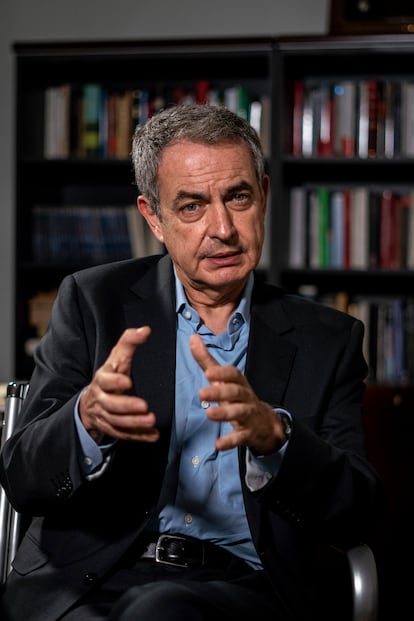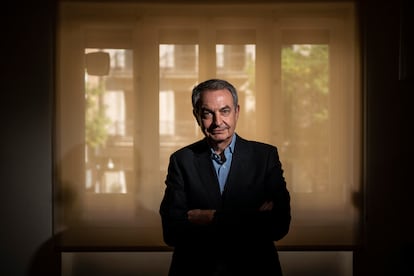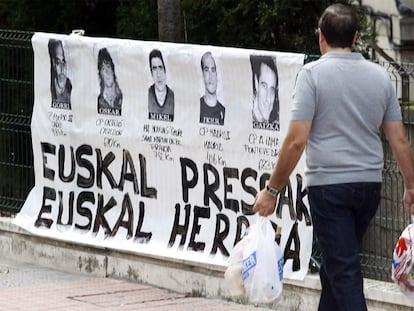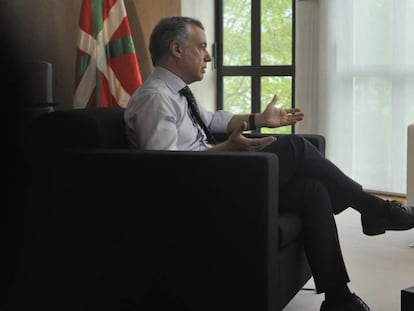The end of Basque terror group ETA: ‘It was unilateral, clean and without trade-offs’
Former Spanish prime minister José Rodríguez Zapatero talks to EL PAÍS about the events leading up to the organization’s decision to terminate its campaign of violence


When José Luis Rodríguez Zapatero of the Socialist Party (PSOE) was elected the prime minister of Spain in 2004, the Basque terrorist group ETA had been terrorizing the country for four decades and had killed more than 800 people. Governments had fought with and undermined the organization, but its dissolution remained one of Spanish’s democracy’s overriding challenges. Zapatero’s two terms as prime minister, from 2004 to 2011, framed ETA’s final years. These began with a process of negotiation between the government and the group, and ended on October 20, 2011, when ETA announced a permanent end to its violent struggle, a month before Zapatero left power.
On the 10th anniversary of this declaration, Zapatero tells EL PAÍS that the process was unlike the negotiations that had been conducted with other terrorist organizations, such as the Irish Republican Army (IRA) in Ireland and the Revolutionary Armed Forces of Colombia (FARC) in Colombia, given that ETA took a unilateral decision. This unilateral aspect meant the group reaffirmed the definitive nature of the decision, avoiding reproaches for non-compliance, an issue that has derailed similar processes. Zapatero stresses that he knew about the organization’s decision two months before it was announced, and the content of the final declaration, two days before it was declared. “Ever since I arrived at La Moncloa [the seat of government in Spain], my aim has been to eradicate violence,” he says. “It has been the most important and exciting task of my life.”
Zapatero points out that the end of terrorism was due to two main factors: the internal debate within the ranks of the Basque radical left, known as the abertzale, and the determination of his government to persist with dialogue. But the key decision in the process was the commitment to maintain a permanent dialogue with the international facilitators and mediators from the Swiss center Henri Dunant, which had a direct link with ETA, even when the terrorists broke off the negotiations and detonated a bomb in Terminal 4 of the Adolfo Suárez Madrid-Barajas airport, killing two Ecuadorian citizens. Zapatero knew immediately that the attack would trigger a response among the abertzale, led by Arnaldo Otegi, who at the time was the leader of the Basque nationalist party Batasuna, and is now the head of the leftist coalition EH Bildu.
According to Zapatero, the seeds for peace were planted during the dialogue between the president of the Basque branch of the Socialist Party (PSE), Jesús Eguiguren, and Otegi. Eguiguren informed Zapatero that he was in informal contact with Otegi, who wanted the government and ETA to open negotiations. At that time, the terror group was weak. It had been a year since it had targeted its last victim, and there was an increasing amount of criticism of the violence among the radical left.
Rubalcaba, chosen to direct the process for his “intelligence.” Zapatero chose his interior minister, Alfredo Pérez Rubalcaba, to direct the peace process on account of his “intelligence and strategic abilities.” Having received a 10-point letter from ETA asking for dialogue, the negotiations were put into gear. “I was always convinced that without dialogue there would be no end to terrorism,” says Zapatero. “ETA had its roots in society. That is why it had survived for so many years. We had to win the battle of public opinion in favor of peace and dialogue. [Former PSOE prime minister] Felipe González and [former conservative Popular Party prime minister] José María Aznar had tried and failed. But the numbers criticizing the violence had increased. I was convinced the critical trend continued to grow because terrorism was incomprehensible. That is why I took the risk and persisted.”
Between June and July of 2005, Jesús Eguiguren, named by Zapatero as the government’s interlocutor, and José Antonio Urrutikoetxea, alias “Josu Ternera,” who spoke on behalf of ETA, met in Geneva in Switzerland. A method had been agreed upon. “It was inspired by the Ajuria Enea Pact signed by the Basque democratic parties, including the Popular Party, against ETA,” says Zapatero. “It allowed dialogue with the organization if it committed to surrendering its weapons, and would be limited to the issue of prisoners and disarmament. Political issues, which were in the hands of the parties, were set aside. We had no other reference because there is nothing written in law. We took the Ajuria Enea bases to parliament, which approved them, and we opened the process, after ETA declared the ceasefire.”
The dialogue between the government and ETA lasted just nine months, from March to December 2006, before it stalled. In December, ETA bombed the Adolfo Suárez Madrid-Barajas airport and killed two Ecuadorian citizens. Those who opposed the negotiations within the organization had prevailed. “I remember the victims of that attack clearly,” says Zapatero. “It was very painful. I felt responsible. I asked for forgiveness.” It so happened that the day before the attack, Zapatero had declared: “Next year, things will be better.” He attributes this mistake to the fact that he had information that the process was going reasonably, but that this information could be misinterpreted.
The Barajas bombing. Paradoxically, the Barajas tragedy was the “decisive moment” that led to the end of ETA, according to Zapatero. “It brought us to a crossroads: on the one hand, the consideration that there was no hope left and everything would then be limited to police action, and on the other, it would be the moment when the supporters of the Basque nationalist movement who were in favor of putting an end to violence would react,” he says. “I thought that the latter would prevail because we had information that this contingent considered the attack incomprehensible and unacceptable. Rubalcaba played a key role at that time. I shared his opinion and that of Eguiguren that the attack triggered the confrontation between the pro-independence left, led by Otegi, and ETA.”
Zapatero divides the end of ETA into three stages. The first was the pre-negotiations between Eguiguren and Otegi. The second, the talks between the government and ETA. And the third, the post-dialogue, prompted by the Barajas bombing and the breaking of the ceasefire by ETA.
“The government’s moral authority and deep conviction that it was possible to put an end to terrorism through dialogue stimulated the debate among the abertzale,” Zapatero says. “I took this into account in my decisions. I knew that they had an echo in that world and I wanted them to know, after the attack, that I was still convinced it was the end. We then saw that the attack had provoked a definitive rift.”

The international mediators. At that time, the role of the international facilitators and mediators was crucial, specifically that of the Henri Dunant Center in Geneva, whose director was Martin Griffiths. The facilitators maintained a connection with the sector of ETA that wanted to end the violence. “My decision to maintain indirect contact, without any formality or recognition, was key,” says Zapatero. “They did a very discreet and effective job. They promoted and nurtured the idea of the end. Without them, we would not have had the ending we had. I hope one day society will recognize that. I had the opportunity to tell them so in a very emotional reunion.”
Support from Europe. Zapatero also appreciates the role of a number of European governments, especially the Norwegian and Swiss. Both countries provided the backdrop for the meetings between the Spanish government and ETA, and they were in charge of security. “The support of the European governments for the dialogue was absolute. I recall [former UK prime minister] Tony Blair, the French president, Nicolas Sarkozy, and the United States, all of whose positions contrasted with the short-sightedness of the conservative opposition in Spain.”
While the Basque radical left began its catharsis, ETA launched its last offensive. After the Barajas attack, it assassinated two Civil Guards in Cap Breton in France in 2007 and two police officers in Palma de Mallorca in July 2009. In May 2010, the organization committed its last murder: a police officer called Serge Nerin, near Paris. The government responded by arresting the ETA leaders who led the offensive: Francisco Javier López Peña alias “Thierry,” Mikel Garikoitz Aspiazu alias “Txeroki” and Aitzol Iriondo Yarza alias “Gurbitz y Barbas.”
“Votes or bombs.” At that moment, Interior minister Rubalcaba proposed to the Basque radical left that it was a case of “either votes or bombs.” Otegi was imprisoned, accused of reorganizing the abertzale left. Eguiguren disagreed but Rubalcaba considered it necessary to put pressure on the pro-independence left to get them to commit to a position against ETA. Zapatero says it was a judicial decision, pointing out: “Police efficiency had been in place for years. One ETA leadership replaced another. The key was political: the Basque nationalist left and ETA needed to reflect on the end. It took time. Longer than I thought. But it happened.”
At the time of his arrest, Otegi was in the process of unifying the Basque nationalist parties Eusko Alkartasuna, Aralar and Alternatiba, as well as Batasuna (which was outlawed in 2003), and was preparing a manifesto, Zutik Euskal Herria, which rejected violence, according to sources from EH Bildu, which was formed in 2011. The manifesto was voted on in the assemblies of the leftist nationalist parties and was approved by 80%. For the first time, ETA found itself challenged. It was February 2010.
In May, security forces arrested ETA military chief Mikel Carrera, who was in favor of pursuing terrorism. Rubalcaba pointed out that this facilitated the Basque radical left’s intentions to end the violence. In September, ETA declared a new ceasefire. At that point, the political line championed by Otegi prevailed, according to those heading up the anti-terrorist struggle.
In January 2011, ETA eliminated extortion and kale borroka – the so-called street fight or guerilla warfare that was waged mainly by Basque nationalist youths. And in February, the abertzale presented new statutes, and launched the political party Sortu, which rejected ETA terrorism. In May, the nationalist groups, unified as EH Bildu by Otegi, competed in the municipal elections with no objection from Spain’s Constitutional Court.

The last chapter of ETA’s demise began in the summer of 2011 and culminated in October. The international facilitators, with the help of the Norwegian government, communicated to Zapatero that ETA had proposed an end to its terrorist campaign. But it was asking for an international stage and the pending legalization of the left-wing Basque nationalist party Sortu, which was banned from registering as a political party by Spain’s Supreme Court in 2011 – a decision that prompted the creation of EH Bildu. Norway agreed to take in three ETA leaders, among them Josu Ternera.
“I gave the go-ahead,” says Zapatero. “We were aware of the Basque nationalist obsession with what they called internationalizing the conflict. For us, the Declaration of Aiete [produced at the Donostia-San Sebastián International Peace Conference] did not imply any political commitment. As for the legalization of Sortu, we considered that having rejected violence in its statutes, it complied with the postulates of the Ajuria Enea Pact. The courts decided to legalize it. In September, they confirmed the final decision and in October, we were just waiting for the day. Two days prior to its release, we learned of ETA’s statement.”
The end of ETA differed significantly from other peace processes, such as the Irish or Colombian peace talks, according to Zapatero. “It was unilateral, clean and without trade-offs. This avoided the risk of triggering other processes due to complaints of non-compliance. Ten years later, we can say that it was permanent.”
October 20, 2011, marked a milestone in the history of Spain when ETA put an end to five decades of terrorism that claimed the lives of 850 people and injured thousands more. “It was the most exciting day of my life,” says Zapatero. “It ended the ’shot in the back of the head’ for good. Every day I think about the victims. We must appreciate peace more and unite as a country to recognize them.”
Political responses. Zapatero flags up Otegi’s leadership of the Basque radical left in putting an end to ETA’s terrorist violence. “The conditions for the end were there. But things do not change without leadership. Otegi exercised it, and was at the heart of the process. Eguiguren’s influence on him was key.”
Years later, in September 2018, Zapatero met Arnaldo Otegi. They talked about the pending need for the Basque radical left to examine its past complicity with ETA’s terrorist violence. “They have to do it,” says Zapatero. “They need time. It must come from them as it did with the end of ETA. We can all contribute to this by encouraging debate. We will be listening to them.” Zapatero considers Jesús Eguiguren, leader of the Basque branch of the PSOE, “decisive” and highlights the conviction and generosity he showed throughout the entire process of dialogue with the terrorists.
The former prime minister also appreciates the support that was given by the Basque Nationalist Party (PNV). “Iñigo Urkullu [current premier of the Basque region] was not a protagonist,” he says. “But he helped me in everything I asked for. That was important due to the influence of the PNV in Basque society.”
With respect to Mariano Rajoy, the then leader of the Popular Party who remained in opposition during the entire process as well as the years that followed until the definitive end of the terrorist violence, Zapatero criticizes his mixed attitude. “[Rajoy] was livid during the dialogue process,” he says. “But he recognized that the end of ETA had no trade-offs and he took it on board. He was given continuous and exhaustive information.”
Cessation of terror over five years
June 29, 2006. Zapatero starts the dialogue with ETA. Spanish prime minister José Luis Rodríguez Zapatero announces the beginning of the dialogue with ETA in the Congress of Deputies; it had started a few days earlier in Geneva and continued in Oslo.
December 30, 2006. Attack at Terminal 4 of Madrid-Barajas airport. A bomb detonated by ETA causes two deaths in a parking lot in Madrid’s airport, breaking the ceasefire. The talks with ETA that Zapatero had authorized 18 months earlier were stalled, although they would continue, without any formal recognition, for several more months.
May 20, 2008. Arrest of Thierry, ETA’s “number one.” The Spanish Civil Guard and the French police arrest four ETA terrorists in Bordeaux, France, among them the man considered to be the group’s top leader, Francisco Javier López Peña, alias “Thierry.” López Peña had participated in some of the peace talks with government representatives.
November 17, 2008. Arrest of ETA leader, “Txeroki.” French police arrest Mikel Garikoitz Aspiazu, alias “Txeroki,” who had succeeded Thierry as the head of ETA, in Cauterets, southwest France.
October 13, 2009. Arrest of Arnaldo Otegi, leader of Batasuna. An operation ordered by Judge Baltasar Garzón concludes with the arrest in the Basque province of Gipuzkoa of 10 leaders of the Baque radical left, among them Arnaldo Otegi, the leader of the political party Batasuna, which was banned in 2003. The operation was aimed at preventing the party from reforming its main organ of power, the National Council.
May 20, 2010. Arrest of “Ata,” head of ETA. ETA’s boss after the arrest of Txeroki, Mikel Kabikoitz Carrera Sarobe, alias “Ata,” is arrested in an apartment in Bayonne, France, along with two other terrorists.
October 20, 2011. ETA announces a definitive end to terrorist violence. Three masked members of ETA read out a statement in which the terrorist organization commits to the definitive surrender of its weapons. Six and a half years later, on May 3, 2018, the gang announces its definitive dissolution.
Tu suscripción se está usando en otro dispositivo
¿Quieres añadir otro usuario a tu suscripción?
Si continúas leyendo en este dispositivo, no se podrá leer en el otro.
FlechaTu suscripción se está usando en otro dispositivo y solo puedes acceder a EL PAÍS desde un dispositivo a la vez.
Si quieres compartir tu cuenta, cambia tu suscripción a la modalidad Premium, así podrás añadir otro usuario. Cada uno accederá con su propia cuenta de email, lo que os permitirá personalizar vuestra experiencia en EL PAÍS.
¿Tienes una suscripción de empresa? Accede aquí para contratar más cuentas.
En el caso de no saber quién está usando tu cuenta, te recomendamos cambiar tu contraseña aquí.
Si decides continuar compartiendo tu cuenta, este mensaje se mostrará en tu dispositivo y en el de la otra persona que está usando tu cuenta de forma indefinida, afectando a tu experiencia de lectura. Puedes consultar aquí los términos y condiciones de la suscripción digital.
More information
Últimas noticias
Most viewed
- Reinhard Genzel, Nobel laureate in physics: ‘One-minute videos will never give you the truth’
- Oona Chaplin: ‘I told James Cameron that I was living in a treehouse and starting a permaculture project with a friend’
- Pablo Escobar’s hippos: A serious environmental problem, 40 years on
- Why we lost the habit of sleeping in two segments and how that changed our sense of time
- Charles Dubouloz, mountaineering star, retires at 36 with a farewell tour inspired by Walter Bonatti










































